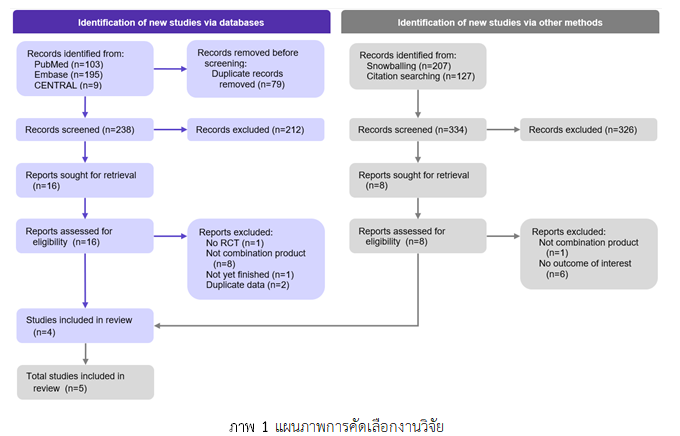Clinical Effects of a Mixture Capsule Containing Hibiscus Sabdariffa L. (Rosella) and Lippia Citriodora L. (Lemon Verbena) on Obesity Treatment: A Systematic Review and Meta-analysis
Keywords:
Hibiscus sabdariffa L., Lippia citriodora L., obesity, overweightAbstract
The purpose of this systematic review and meta-analysis was to determine the efficacy and safety of a mixture capsule of Hibiscus sabdariffa L. (Rosella) and Lippia citriodora L. (Lemon Verbena) extracts on obesity treatment. Randomized controlled trials (RCT) from PubMed, Embase, and the Cochrane central register of clinical trial (CENTRAL) were searched from the start of each database until March 2023. RCTs studies about the effects of Hibiscus sabdariffa L. and Lippia citriodora L. combination products on obesity treatment were included for subjects aged ≥18 years old who had body mass index (BMI) ≥ 23 kg/m2 or had been diagnosed with being overweight or obese; and reported one of the following clinical outcomes: 1) body weight, 2) BMI, or 3) waist circumference. The quality of the included RCTs was assessed using the Cochrane Risk of Bias version 2 (RoB 2). The results were analyzed under a random-effects model and reported as mean differences (MD) with 95% confidence intervals (95%CI). The Review Manager 5.4 (RevMan 5.4) was used for statistical analysis. The results showed as follows.
1. The intervention group could significantly reduce waist circumference (MD = -4.59 cm, 95%CI = -9.01, -0.16). However, these combination products have no effects on BMI and body weight compared to the placebo group.
2. No adverse events were reported.
This current evidence demonstrated that combination products of Hibiscus sabdariffa L.and Lippia citriodora L.could reduce waist circumference, with no safety concerns. However, further high-quality trials are needed to enhance the confidence of the generated evidence.
References
Anggraini, S., & Kartinah, N. T. (2021). Effectiveness of Hibiscus sabdariffa Linn for Obesity Treatment: A Systematic Review of Randomized Controlled Trials. Indonesian Journal of Medicine, 6(4), 439-451. doi:10.26911/theijmed.2021.06.04.10
Boix-Castejón, M., Herranz-López, M., Olivares-Vicente, M., Campoy, P., Caturla, N., & Jones, J., et al. (2021). Effect of metabolaid® on pre- and stage 1 hypertensive patients: A randomized controlled trial. Journal of Functional Foods, 84. doi:10.1016/j.jff.2021.104583
Boix-Castejon, M., Herranz-Lopez, M., Perez Gago, A., Olivares-Vicente, M., Caturla, N., & Roche, E., et al. (2018). Hibiscus and lemon verbena polyphenols modulate appetite-related biomarkers in overweight subjects: a randomized controlled trial. Food Funct, 9(6), 3173-3184. doi:10.1039/c8fo00367j
Boonchaya-anan, P., & Vorasetthakankit, Y. (2015). Guidelines for overweight and obese people. Bangkok: The Royal College of Physicians of Thailand. (in Thai)
Cádiz-Gurrea, M. d. l. L., Olivares-Vicente, M., Herranz-López, M., Arraez-Roman, D., Fernández-Arroyo, S., Micol, V., & Segura-Carretero, A. (2018). Bioassay-guided purification of Lippia citriodora polyphenols with AMPK modulatory activity. Journal of Functional Foods, 46, 514-520. doi:10.1016/j.jff.2018.05.026
Chang, H. C., Peng, C. H., Yeh, D. M., Kao, E. S., & Wang, C. J. (2014). Hibiscus sabdariffa extract inhibits obesity and fat accumulation, and improves liver steatosis in humans. Food Funct, 5(4), 734-739. doi:10.1039/c3fo60495k
Department of Health. (2022). Health Promotion and Environmental Health Surveillance: Annual Report 2022. Bangkok: Dharmniti seminar and trainning. (in Thai)
Diez Echave, P., Vezza, T., Rodríguez Nogales, A., Hidalgo Garcia, L., Garrido Mesa, J., & Ruiz Malagon, A., et al. (2020). The Beneficial Effects of Lippia Citriodora Extract on Diet Induced Obesity in Mice Are Associated with Modulation in the Gut Microbiota Composition. Molecular Nutrition & Food Research, 64(13). doi:10.1002/mnfr.202000005
El Hadi, H., Di Vincenzo, A., Vettor, R., & Rossato, M. (2018). Food Ingredients Involved in White-to-Brown Adipose Tissue Conversion and in Calorie Burning. Front Physiol, 9, 1954. doi:10.3389/fphys.2018.01954
Gagnier, J. J., Boon, H., Rochon, P., Moher, D., Barnes, J., & Bombardier, C. (2006). Recommendations for reporting randomized controlled trials of herbal interventions: Explanation and elaboration. J Clin Epidemiol, 59(11), 1134-1149. doi:10.1016/j.jclinepi.2005.12.020
Herranz-Lopez, M., Olivares-Vicente, M., Boix-Castejon, M., Caturla, N., Roche, E., & Micol, V. (2019). Differential effects of a combination of Hibiscus sabdariffa and Lippia citriodora polyphenols in overweight/obese subjects: A randomized controlled trial. Sci Rep, 9(1), 2999. doi:10.1038/s41598-019-39159-5
Higgins, J. P., Li, T., & Sterne, J. (2021). Revised Cochrane risk of bias tool for randomized trials (RoB 2) Additional considerations for crossover trials. Retrieved from https://www.riskofbias.info/welcome/rob-2-0-tool/rob-2-for-crossover-trials
Institute of Medical Research and Technology Assessment. (2010). Clinical practice guidelines for the prevention and treatment of obesity. Bangkok: The Agricultural Co-operatives Federation of Thailand. (in Thai)
Kwankhao, P. (2012). Plants around us. Bangkok: Pauramutha Karn Pim. (in Thai)
Lee, Y. S., Yang, W. K., Kim, H. Y., Min, B., Caturla, N., & Jones, J., et al. (2018). Metabolaid® Combination of Lemon Verbena and Hibiscus Flower Extract Prevents High-Fat Diet-Induced Obesity through AMP-Activated Protein Kinase Activation. Nutrients, 10(9). doi:10.3390/nu10091204
Marhuenda, J., Perez, S., Victoria-Montesinos, D., Abellan, M. S., Caturla, N., & Jones, J., et al. (2020). A Randomized, Double-Blind, Placebo Controlled Trial to Determine the Effectiveness a Polyphenolic Extract (Hibiscus sabdariffa and Lippia citriodora) in the Reduction of Body Fat Mass in Healthy Subjects. Foods, 9(1). doi:10.3390/foods9010055
Sabzghabaee, A. M., Ataei, E., Kelishadi, R., Ghannadi, A., Soltani, R., Badri, S., & Shirani, S. (2013). Effect of Hibiscus sabdariffa Calices on Dyslipidemia in Obese Adolescents: A Triple-masked Randomized Controlled Trial. Mater Sociomed, 25(2), 76-79. doi:10.5455/msm.2013.25.76-79
Serna, A., Marhuenda, J., Arcusa, R., Perez-Pinero, S., Sanchez-Macarro, M., & Garcia-Munoz, A. M., et al. (2022). Effectiveness of a polyphenolic extract (Lippia citriodora and Hibiscus sabdariffa) on appetite regulation in overweight and obese grade I population: an 8-week randomized, double-blind, cross-over, placebo-controlled trial. Eur J Nutr, 61(2), 825-841. doi:10.1007/s00394-021-02678-x
Sterne, J. A. C., Savović, J., Page, M. J., Elbers, R. G., Blencowe, N. S., & Boutron, I., et al. (2019). RoB 2: a revised tool for assessing risk of bias in randomised trials. Bmj. doi:10.1136/bmj.l4898

Downloads
Published
Issue
Section
License
Copyright (c) 2023 The Southern College Network Journal of Nursing and Public Health

This work is licensed under a Creative Commons Attribution-NonCommercial-NoDerivatives 4.0 International License.
1. บทความหรือข้อคิดเห็นใด ๆ ที่ปรากฏในวารสารเครือข่าย วิทยาลัยพยาบาลและการสาธารณสุขภาคใต้ ที่เป็นวรรณกรรมของผู้เขียน บรรณาธิการหรือเครือข่ายวิทยาลัยพยาบาลและวิทยาลัยการสาธารณสุขภาคใต้ ไม่จำเป็นต้องเห็นด้วย
2. บทความที่ได้รับการตีพิมพ์ถือเป็นลิขสิทธิ์ของ วารสารเครือข่ายวิทยาลัยพยาบาลและการสาธารณสุขภาคใต้







